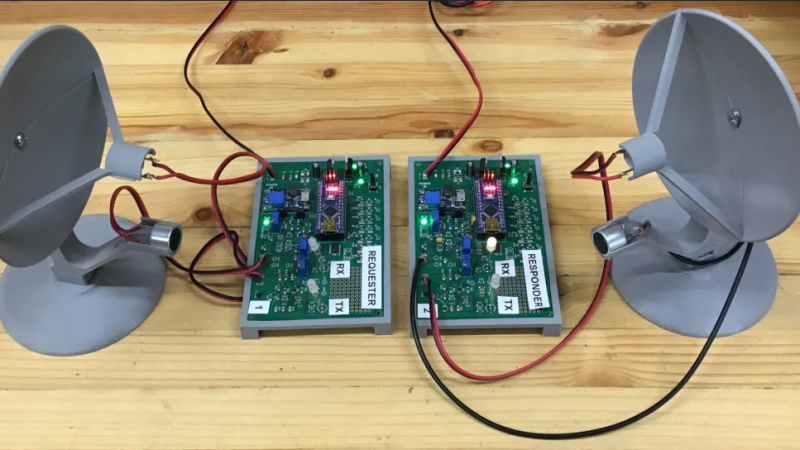We know what you’re thinking: with so many wireless modules available for just pennies, trying to create a physical data link using ultrasonic transducers like [Damian Bonicatto] did for a short-range, low-bitrate remote monitoring setup seems like a waste of time. And granted, there are a ton of simple RF protocols you can just throw at a job like this. Something like this could be done and dusted for a couple of bucks, right?
Luckily, [Damian] wanted something a little different for his wireless link to a small off-grid solar array, which is why he started playing with ultrasound in an SDR framework. The design for his “Software-Defined Ultrasonics” system, detailed in Part 1, has a pair of links, each with two ultrasonic transducers, one for receiving and one for transmitting. Both connect to audio amplifiers with bandpass filters; the received signal is digitized by the ADC built into an Arduino Nano, while the transmitted signal is converted to analog by an outboard DAC.
The transducers are affixed to 3D printed parabolic reflectors, which are aimed at each other over a path length of about 150′ (46 m). Part 2 of the series details the firmware needed to make all this work. A lot of the firmware design is dictated by the constraints introduced by using Arduinos and the 40-kHz ultrasonic carrier, meaning that the link can only do about 250 baud. That may sound slow, but it’s more than enough for [Damian]’s application.
Perhaps most importantly, this is one of those times where going slower helps you to go faster; pretty much everything about the firmware on this system applies to SDRs, so if you can grok one, the other should be a breeze. But if you still need a little help minding your Is and Qs, check out [Jenny]’s SDR primer.

















This is within the hearing range of dogs. A really smart one could eavesdrop on the transmission.
Dogs could use this to rule the world.
They won’t. They are not cats.
And cats don’t have to; They already rule.
Is that dog’s name Eve?
And cats. I have played numerous times with low power 40 KHz transducers, those commonly used in remote controls, and every time my cats run into the lab meowing. Those weren’t subharmonics o other signals lower in frequency; I also fed the transducers with the sine wave produced by a signal generator with identical results.
Beware that pets and other animals will almost certainly be annoyed by projects like this.
Surely it should be called SDU (Software-Defined Ultrasonics), since there is no actual EM signals being broadcast. Like if it was Radio, the transmissions would be in the 30kHz to 300 kHz LF (Low Frequency) band.
Never mind, I just read the links and they use the name SDU-X.
I get using to try something new and learn something. But this is not just another plate to keep spinning, it’s a spinning cast iron skillet when you’re already dealing with keeping the plates spinning. E.g. it’s not going to make the spinning plates any easier, adding one more plate to the set is less disruption than adding something completely different to keep working.
Kudos for making the effort.
Maybe he (or somebody) should try this with infrasonics. Elephants use it to communicate over distances of miles, although the data rate may be slow you’ll always have large grey friends.
They do make good friends — and even worse enemies…
Elephants never forget, or forgive!
Infrasonics are used already in oil well drilling to transmit data through drilling mud.
Kinda done…70 years ago and used green energy.
https://www.theverge.com/23810061/zenith-space-command-remote-control-button-of-the-month
Cool technology!
Well, with such a breakthrough technology one could … remote control a TV
https://www.wired.com/images_blogs/gadgetlab/2010/10/IMG_0375.jpg
I like the idea of 3D printing little parabolic reflectors – with an huge array of these I could eavesdrop on all my neighbors.
This is brilliant as it lets you teach a lot of concepts of modulation and link budgets and stuff, without any FCC concerns whatsoever. The signals don’t even go through walls, so the neighboring classroom is unlikely to interfere.
I like the idea. But I was hoping for a more advanced modulation method for higher bandwidth. Or combining multiple transceivers tuned at different frequencies. The current design could easily be made entirely analog.
“with so many wireless modules available for just pennies”
Ultrasonic wireless modules?
RF doesn’t work so well underwater.
basically a pair of modems with higher pitch
nice